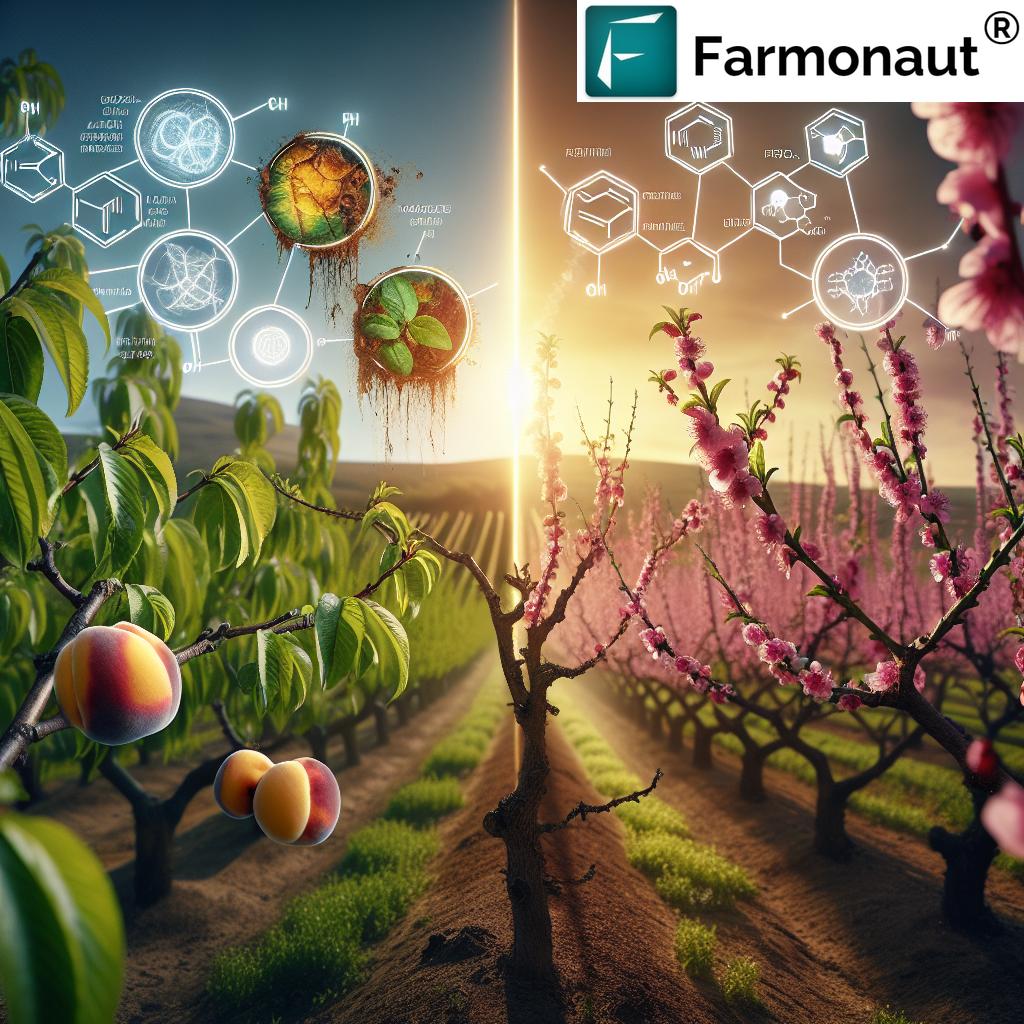Aphids Unveiled: From Mango Pests to Hairy Species – Essential Guide for Farmers

Welcome to our comprehensive guide on aphids, those tiny yet formidable pests that can wreak havoc on crops worldwide. At Farmonaut, we understand the challenges farmers face when dealing with these persistent insects. In this blog, we’ll delve deep into the world of aphids, exploring various species, their impact on crops, and effective management strategies. Whether you’re battling mango aphids or curious about the hairy aphid, we’ve got you covered.
What is an Aphid?
What is aphid? Aphids are small, soft-bodied insects that belong to the superfamily Aphidoidea. These pests are among the most destructive insects in temperate climates and can be found in virtually every part of the world. Aphids are known for their rapid reproduction and their ability to transmit plant viruses, making them a significant concern for farmers and gardeners alike.
Key Characteristics of Aphids:
- Size: Typically 1-10 mm long
- Colors: Can range from green, black, brown, to pink, depending on the species
- Body Structure: Pear-shaped body with long antennae
- Feeding Mechanism: Piercing-sucking mouthparts to extract plant sap
- Reproduction: Can reproduce both sexually and asexually
Aphids are notorious for their ability to quickly infest crops and ornamental plants. They feed on plant sap, which can lead to various issues such as stunted growth, leaf distortion, and the transmission of plant viruses. Understanding these tiny pests is crucial for effective crop management and protection.
Types of Aphids
There are over 5,000 known species of aphids, each with its own characteristics and preferred host plants. In this section, we’ll focus on some of the most common and economically significant aphid species that farmers often encounter.
1. Mango Aphid (Toxoptera odinae)
The mango aphid is a significant pest for mango growers worldwide. These aphids are typically dark brown to black in color and target young shoots, leaves, and developing fruit clusters.
- Host Plants: Primarily mango trees, but can also infest other fruit trees
- Damage: Causes leaf curling, stunted growth, and can transmit mango malformation disease
- Identification: Look for clusters of dark-colored aphids on new growth and under leaves
2. Green Peach Aphid (Myzus persicae)
One of the most widespread and destructive aphid species, the green peach aphid affects a wide range of crops.
- Host Plants: Over 400 plant species, including peaches, potatoes, and many vegetables
- Damage: Causes leaf curling, yellowing, and is a vector for numerous plant viruses
- Identification: Pale green to yellow-green in color, with distinctive red eyes
3. Cotton Aphid (Aphis gossypii)
Also known as the melon aphid, this species is a major pest in cotton and cucurbit crops.
- Host Plants: Cotton, melons, cucumbers, and various other crops
- Damage: Causes stunted growth, leaf distortion, and honeydew production
- Identification: Varies in color from light green to dark green or nearly black
4. Hairy Aphid (Sipha maydis)
The hairy aphid is named for its distinctive appearance and is particularly problematic for cereal crops.
- Host Plants: Primarily grasses and cereal crops like wheat, barley, and oats
- Damage: Causes yellowing of leaves and can transmit barley yellow dwarf virus
- Identification: Dark green to brown, with noticeable hairs covering the body
5. Woolly Apple Aphid (Eriosoma lanigerum)
This aphid species is particularly damaging to apple orchards and is recognized by its waxy, wool-like covering.
- Host Plants: Apple trees, occasionally other fruit trees
- Damage: Causes gall formation on roots and branches, weakening the tree
- Identification: Reddish-brown body covered with a white, woolly wax secretion

Understanding the different types of aphids is crucial for implementing targeted control measures. At Farmonaut, our satellite-based crop monitoring system can help detect early signs of aphid infestations across various crop types. Learn more about our crop monitoring solutions.
Aphid Reproduction and Life Cycle
One of the most remarkable aspects of aphids is their incredible aphid reproduction rate. Understanding this process is key to developing effective control strategies.
Asexual Reproduction (Parthenogenesis)
During the growing season, female aphids can reproduce asexually through a process called parthenogenesis. This allows for rapid population growth under favorable conditions.
- Female aphids give birth to live young (nymphs) without mating
- Nymphs are born pregnant, carrying the next generation
- A single aphid can produce up to 80 offspring in a week
- Under ideal conditions, aphid populations can double every 3-4 days
Sexual Reproduction
As environmental conditions change, typically in autumn, aphids switch to sexual reproduction.
- Males are produced alongside females
- Mating occurs, and females lay eggs that overwinter
- Eggs hatch in spring, starting the cycle anew
Life Cycle Stages
- Egg: Overwinters on host plants
- Nymph: Passes through 4-5 instars (molting stages)
- Adult: Reaches sexual maturity in about a week
The rapid aphid reproduction rate is a key factor in their success as agricultural pests. It allows them to quickly establish large colonies and adapt to changing environmental conditions. This reproductive strategy makes early detection and intervention crucial for effective aphid management.
Crop Damage Caused by Aphids
Aphid infection can lead to significant crop damage through various mechanisms. Understanding these effects is essential for farmers to recognize early signs of infestation and take appropriate action.
Direct Feeding Damage
- Leaf Curling: As aphids feed, they inject saliva that causes leaves to curl and distort
- Stunted Growth: Heavy infestations can stunt plant growth by depleting nutrients
- Yellowing: Chlorosis (yellowing of leaves) can occur due to nutrient deficiency caused by aphid feeding
- Wilting: Severe infestations can lead to plant wilting and eventual death
Honeydew Production
Aphids excrete a sticky substance called honeydew as they feed, which can cause additional problems:
- Sooty Mold Growth: Honeydew provides a medium for sooty mold fungi to grow, reducing photosynthesis
- Attracting Other Pests: The sweet substance can attract ants and other insects
- Quality Reduction: Honeydew can make fruits and vegetables unmarketable
Virus Transmission
Many aphid species are vectors for plant viruses, which can cause severe crop losses:
- Mosaic Viruses: Common in vegetables and ornamental plants
- Yellows Viruses: Affect a wide range of crops, including cereals and legumes
- Leaf Roll Viruses: Particularly damaging to potato crops
Economic Impact
The damage caused by aphid disease and infestation can have significant economic consequences:
- Yield Reduction: Heavy infestations can reduce crop yields by up to 40%
- Quality Degradation: Aphid damage can lower the market value of produce
- Increased Production Costs: Managing aphid outbreaks often requires additional pesticide applications and labor
Early detection of aphid infestations is crucial for minimizing crop damage. Farmonaut’s satellite-based monitoring system can help detect early signs of stress in crops, potentially indicating aphid presence. Download our app to start monitoring your crops more effectively.
Aphids vs. Jassids: Understanding the Difference
Farmers often encounter confusion between aphids and jassids, as both are common agricultural pests. Understanding the difference between aphid and jassid is crucial for implementing the right control measures.
Aphids:
- Appearance: Soft-bodied, pear-shaped insects
- Size: Usually 1-10 mm long
- Movement: Slow-moving, often found in clusters
- Feeding: Suck sap from plants using piercing-sucking mouthparts
- Damage: Cause leaf curling, stunted growth, and virus transmission
- Reproduction: Can reproduce both sexually and asexually
Jassids (Leafhoppers):
- Appearance: Wedge-shaped body with wings held tent-like over the body
- Size: Generally 3-15 mm long
- Movement: Quick and agile, often jumping when disturbed
- Feeding: Also use piercing-sucking mouthparts but tend to feed on leaf undersides
- Damage: Cause stippling on leaves, “hopper burn,” and potential virus transmission
- Reproduction: Only reproduce sexually
Key Differences:
- Body Shape: Aphids are more rounded, while jassids are distinctly wedge-shaped
- Mobility: Jassids are much more active and can quickly hop away when disturbed
- Colony Formation: Aphids often form dense colonies, while jassids are more solitary
- Damage Patterns: Aphids cause more leaf curling, while jassids typically cause stippling
- Reproduction: Aphids can reproduce asexually, leading to faster population growth
Recognizing these differences is essential for proper pest identification and management. While both pests can cause significant damage, their control methods may differ. Farmonaut’s advanced imaging technology can help in early detection of both aphid and jassid infestations, allowing for timely intervention. Get our iOS app for real-time crop monitoring.
Aphid Management Strategies
Effective management of aphids requires an integrated approach that combines various strategies. Here, we outline some of the most effective methods for controlling aphid populations and minimizing crop damage.
1. Cultural Control
- Crop Rotation: Rotate crops to disrupt aphid life cycles
- Intercropping: Plant aphid-repelling crops alongside susceptible ones
- Proper Irrigation: Avoid over-watering, which can create favorable conditions for aphids
- Weed Management: Remove weeds that can serve as alternative hosts for aphids
2. Biological Control
- Beneficial Insects: Encourage natural predators like ladybugs, lacewings, and parasitic wasps
- Entomopathogenic Fungi: Use fungi that specifically target aphids
- Companion Planting: Grow plants that attract aphid predators
3. Chemical Control
- Insecticidal Soaps: Effective against soft-bodied insects like aphids
- Neem Oil: A natural insecticide that disrupts aphid feeding and reproduction
- Systemic Insecticides: For severe infestations, used as a last resort
- Note: Always follow label instructions and consider the impact on beneficial insects
4. Physical Control
- Water Sprays: Use strong jets of water to dislodge aphids from plants
- Pruning: Remove heavily infested plant parts
- Reflective Mulches: Use silver-colored mulches to repel aphids
5. Monitoring and Early Detection
- Regular Scouting: Inspect crops regularly for signs of aphid presence
- Sticky Traps: Use yellow sticky traps to monitor aphid populations
- Satellite Monitoring: Utilize Farmonaut’s satellite-based crop monitoring for early detection of stress signs
6. Resistance Management
- Crop Varieties: Choose aphid-resistant crop varieties when available
- Rotate Control Methods: Avoid relying on a single control method to prevent resistance development
Implementing an integrated pest management (IPM) approach that combines these strategies can significantly reduce aphid populations and minimize crop damage. Farmonaut’s advanced monitoring tools can play a crucial role in early detection and informed decision-making. Learn more about our crop monitoring solutions.
How Farmonaut Helps in Aphid Detection and Management
At Farmonaut, we understand the challenges farmers face in detecting and managing aphid infestations. Our advanced satellite-based monitoring system offers a range of benefits that can significantly improve aphid management strategies.
Early Detection
- Satellite Imagery: Our high-resolution satellite images can detect subtle changes in crop health
- Vegetation Indices: We use advanced vegetation indices like NDVI to identify stressed areas in crops
- AI Analysis: Our AI algorithms can identify patterns associated with aphid infestations
Precise Monitoring
- Field-Level Data: Get detailed information about each field’s health status
- Historical Comparison: Compare current crop health with historical data to identify anomalies
- Regular Updates: Receive frequent updates on crop health throughout the growing season
Targeted Interventions
- Zonal Management: Identify specific areas within fields that require attention
- Resource Optimization: Apply treatments only where needed, reducing costs and environmental impact
- Timing Optimization: Determine the best time for pesticide application or other control measures
Data-Driven Decision Making
- Comprehensive Reports: Access detailed reports on crop health and potential pest issues
- Weather Integration: Correlate pest activity with weather patterns for better prediction
- Expert Insights: Receive recommendations from our team of agricultural experts
Farmonaut vs. Traditional Monitoring Methods
| Feature | Farmonaut Satellite System | Drone-based Monitoring | IoT Sensors |
|---|---|---|---|
| Coverage Area | Large (Entire farms) | Medium | Limited (Point-based) |
| Frequency of Updates | High (Every few days) | Medium (Manual flights required) | High (Real-time possible) |
| Cost-Effectiveness | High | Medium | Low (High initial investment) |
| Ease of Use | Very Easy (No on-field equipment) | Moderate (Requires piloting skills) | Moderate (Requires installation and maintenance) |
| Data Analysis | Advanced (AI-powered) | Moderate | Basic to Advanced |
| Scalability | Highly Scalable | Moderately Scalable | Limited Scalability |
By leveraging Farmonaut’s technology, farmers can stay ahead of aphid infestations, minimizing crop damage and optimizing resource use. Our system provides a comprehensive, cost-effective solution for modern pest management.
Ready to revolutionize your aphid management strategy? Try Farmonaut today and experience the power of satellite-based crop monitoring.
Frequently Asked Questions
1. What are the earliest signs of aphid infestation?
Early signs include curling leaves, sticky residue on leaves (honeydew), and the presence of ants, which are attracted to honeydew. You may also notice stunted growth or yellowing of leaves.
2. How quickly can aphids reproduce?
Aphids have an incredibly high aphid reproduction rate. Under ideal conditions, aphid populations can double every 3-4 days, with a single aphid capable of producing up to 80 offspring in a week.
3. Are all aphids harmful to crops?
While not all aphid species cause significant damage, many are considered agricultural pests. Some species, like the mango aphid, can cause substantial economic losses in specific crops.
4. How can I distinguish between aphid damage and other pest damage?
Aphid damage is often characterized by curled or distorted leaves, stunted growth, and the presence of sticky honeydew. Understanding the difference between aphid and jassid damage, for instance, can help in proper identification.
5. What natural predators can help control aphid populations?
Ladybugs, lacewings, hoverfly larvae, and certain parasitic wasps are effective natural predators of aphids. Encouraging these beneficial insects can help maintain aphid populations at manageable levels.
6. How effective are organic methods in controlling aphids?
Organic methods like using neem oil, insecticidal soaps, and encouraging natural predators can be very effective, especially when implemented as part of an integrated pest management strategy.
7. Can aphids transmit diseases to humans?
While aphids can transmit plant viruses, they do not directly transmit diseases to humans. However, the crop damage caused by aphid disease can impact food security and quality.
8. How does climate change affect aphid populations?
Climate change can lead to milder winters and longer growing seasons, potentially increasing aphid populations and extending their active periods. This makes monitoring and early intervention even more crucial.
9. Are there any aphid-resistant crop varieties available?
Yes, many crop breeding programs have developed varieties with increased resistance to aphids. These varieties can be an effective part of an integrated pest management strategy.
10. How can Farmonaut help in managing aphid infestations?
Farmonaut’s satellite-based monitoring system can detect early signs of crop stress, potentially indicating aphid presence. Our technology allows for targeted interventions, reducing the need for broad-spectrum pesticide applications and improving overall crop health management.
For more information on how Farmonaut can help you manage aphid infestations and improve your crop yield, visit our API documentation or contact our support team.
Conclusion
Understanding and managing aphids is crucial for successful crop production. From recognizing different species like the mango aphid and hairy aphid to implementing effective control strategies, farmers must stay vigilant and informed. By leveraging advanced technologies like Farmonaut’s satellite-based monitoring system, farmers can detect aphid infection early and take timely action to protect their crops.
Remember, successful aphid management requires an integrated approach combining cultural, biological, and chemical control methods. Stay informed, monitor regularly, and don’t hesitate to seek expert advice when needed.
Ready to take your aphid management to the next level? Try Farmonaut’s cutting-edge crop monitoring solutions:
Together, we can revolutionize aphid management and ensure healthier, more productive crops. Join the Farmonaut community today and experience the future of precision agriculture.













